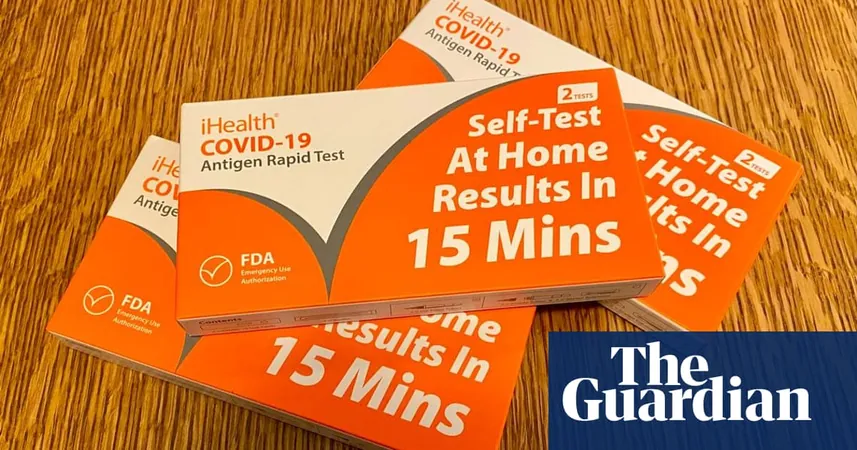
Covid Cases Skyrocket in the US Post-Holiday Season Amidst Alarming Booster Shot Deficiency
2025-01-03
Author: Yan
Covid Cases Skyrocket in the US Post-Holiday Season Amidst Alarming Booster Shot Deficiency
As the holiday festivities wind down, Covid-19 is making an alarming resurgence across the United States, marking a significant shift after a relatively quiet fall season. Compounding this unsettling trend is the strikingly low rate of booster vaccinations among both adults and children, raising urgent public health concerns.
Prominent experts, including Jeffrey Townsend, Elihu Professor of Biostatistics at the Yale School of Public Health, emphasize that the pandemic remains a serious threat. “The Covid pandemic is still ongoing. It’s still dangerous,” Townsend stated. The public’s awareness and clarity regarding the ongoing battle against Covid are essential to combat misinformation and ensure proper preventive measures are being followed.
Recent data indicates an uptick in test positivity rates, emergency room visits, hospitalizations, and fatalities linked to Covid, with signs that the crisis began escalating roughly a month ago. Alarmingly, only 21.4% of adults and a mere 10.3% of children have received the latest booster, released in late August. Even among nursing home residents, a vulnerable demographic, just 37% are current with their Covid vaccinations—an improvement from 23% a year ago, but still insufficient for optimal protection.
Experts fear that vulnerable populations, particularly the elderly, face heightened risks from the virus. “The real worry is that elderly folks will suffer greatly from this disease, if not sometimes die from it,” Townsend remarked. Yet, the threat of Covid is not exclusive to seniors; those of all ages risk not only the immediate health consequences of the virus but also the potential economic impact of missed work and school, along with the possibility of developing long Covid. The CDC’s recent survey reveals that around 5.3% of American adults currently experience long Covid symptoms, while 17.9% have reported having long Covid at some point in their lives.
“The implications of preventing this disease extend beyond just feeling unwell. Covid can cause effects that we may not yet fully understand,” Townsend warned.
Looking back, it has been five years since the initial reports of a concerning pneumonia in China, which we would come to know as Covid-19. Since then, the pattern of infections has oscillated between summer and winter surges. The fall typically sees a continuation of moderate infections from the preceding summer wave, followed by winter spikes peaking in late December or early January. However, this year presents a distinctive pattern—rather than a normal increase, we have observed a prolonged lull before another anticipated surge.
Experts predict that Covid may eventually mimic the behavior of other seasonal viruses, like RSV and flu, settling into a single annual winter spike. However, Townsend cautions that Covid has yet to stabilize into a predictable endemic status. The complexity of its behavior is underscored by the emergence of new variants and the overall levels of immunity among the population—be it via vaccination or prior infection. "The timing of these surges can vary widely, influenced by numerous factors, making precise predictions challenging,” Townsend noted.
Public health monitoring remains critical. Observing wastewater data alongside hospitalization trends provides essential early warnings that allow for a swift response to resurgent waves.
As the nation braces for what is expected to be a challenging winter season, uncertainty looms, particularly regarding the response of the incoming administration to Covid initiatives such as tracking and vaccine updates. Reflecting on the previous administration, Townsend commented that chaos often leads to unpredictability, raising questions on how effectively the pandemic response will be managed moving forward.
With the prevalence of Covid still rampant and booster shot uptake dismal, the focus on vaccination campaigns and public health messaging has never been more crucial. Are we prepared for yet another surge? Time will tell. Stay vigilant!

 Brasil (PT)
Brasil (PT)
 Canada (EN)
Canada (EN)
 Chile (ES)
Chile (ES)
 Česko (CS)
Česko (CS)
 대한민국 (KO)
대한민국 (KO)
 España (ES)
España (ES)
 France (FR)
France (FR)
 Hong Kong (EN)
Hong Kong (EN)
 Italia (IT)
Italia (IT)
 日本 (JA)
日本 (JA)
 Magyarország (HU)
Magyarország (HU)
 Norge (NO)
Norge (NO)
 Polska (PL)
Polska (PL)
 Schweiz (DE)
Schweiz (DE)
 Singapore (EN)
Singapore (EN)
 Sverige (SV)
Sverige (SV)
 Suomi (FI)
Suomi (FI)
 Türkiye (TR)
Türkiye (TR)
 الإمارات العربية المتحدة (AR)
الإمارات العربية المتحدة (AR)